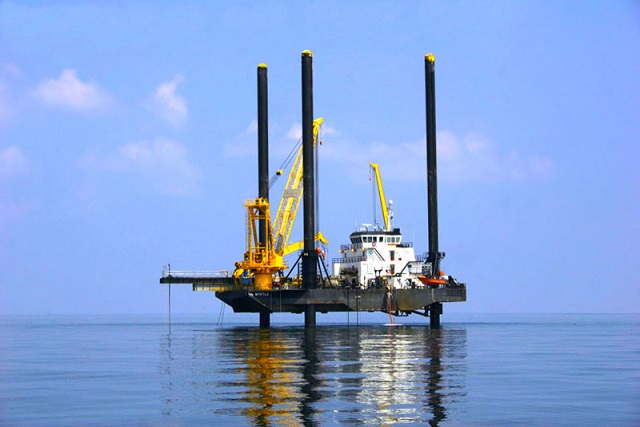 |
 |
||
| Offshore Fleet | ||||||||||||
| Liftboat | ||||||||||||
A liftboat is a self-propelled, multi-purpose, self-elevating vessel. Some have referred to liftboats as jack-up barges, lift barges, jack-boats. We will examine the distinguishing features of a liftboat as compared to its closest cousin, the jack-up drilling rig. Since, a liftboat spends most of its working life out of the water, it is felt it better to address what it does during its working life.
Legs Proven to be a cost effective design, the vast number of liftboats have three columnar legs (pipe legs). Columnar legs and pads provide added buoyancy for the liftboat as the legs are lowered to the sea floor. This buoyancy in both the legs and pads (spud cans) helps reduce the bottom bearing pressure on the pads. In combination with the buoyancy, larger liftboat pads are designed to reduce bottom bearing pressure. This has the effect of less penetration for the typical liftboat. Working water depth also affects the type of leg. After about 220 feet (67 meters) of water, then lattice legs are the norm. The vast majority of liftboats are three-legged. The four-legged liftboat will cost more than the cost of simply adding the cost of another leg, i.e., the jacking system to support two legs loaded diagonally is greater and the hull structure is different/heavier. But operationally, the setup time savings of a four-legged equates to money, so, one has to weigh the costs and benefits of three vs. four legs. Four-legged is faster.
Liftboat Myrtle Class 245' (Montco Offshore) Jacking System The jacking system for a liftboat is very different than the jacking system for a jack-up drilling rig. The two major differences center around speed and cycles. Speed of the liftboat jacking system is essential. While a typical jack-up drilling rig elevates at two feet per minute a liftboat could elevate at four to six feet per minute and lower the legs at 14-18 feet per minute. This gives the liftboat the ability to get on and off location significantly faster. The jacking system for a liftboat encounters a very different operational cycle. It would not be uncommon for a liftboat to jack up and down in one year the same number of times that a jack-up drilling rig would encounter in its entire lifetime. So, the wear factors, redundancy, material grades and shock loads are different between jack-ups and liftboats.
Deck Area The deck area is the unobstructed, open area. The liftboat crane is used to move equipment and materials around and on to and off the platform/offshore location. There is a relationship among these variables – open deck area, net deck load and crane capacity. Further, you need a crane capacity that is commensurate with the expected deck loads and area.
Crane Capacity The value of open deck space, deck load and crane capacity is what makes a liftboat a liftboat. There are a variety of cranes for liftboats. However, there is one caveat – cranes for liftboats are designed by crane manufacturers specifically for liftboats. Weight is a key consideration in liftboat design, so, every consideration needs to be made in the overall design including the crane. Therefore, cranes for liftboats are typically structurally lighter than a comparable offshore crane. Regarding types of liftboat cranes, there are lattice boom, box boom, telescopic boom, pedestal mounted, and leg encircling cranes. The main things to consider in crane selection is reach, load capacities and affect on deck area.
Accommodations The accommodations are another feature of liftboats. The personnel accommodations are generally divided into two areas – navigation crew and customer/operational personnel. As liftboats have gotten bigger with increased capacities, so, has the requirements for more personnel. For example, a 100-man accommodation block would typically have about 20 navigation crew and the remaining 80 for customer/operational personnel.
Propulsion A standard and key feature of a liftboat is that it is self-propelled. This alleviates the need for tugs to move the liftboat or to set up on location. This results in a significant cost advantage in that the liftboat can move to a new location without having to wait on tugs to move them. The liftboat can wait for a weather window and move. The larger liftboats have integrated propulsion and bow thrusters.
Lift boat operations (video)
|
||||||||||||
| « Back to all Offshore Fleet | ||||||||||||

|
|
 |
|
|
||||||||||||
